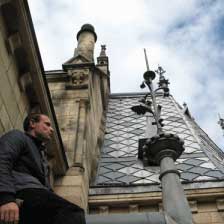Galvanization refers to the coating of steel with zinc. This is done to prevent rusting of the steel. The value of galvanizing stems from the corrosion resistance of zinc, which, under most service conditions, is considerably greater than steel. The zinc serves as a sacrificial anode, so it cathodically protects exposed steel. This means even if the coating is scratched or abraded, the exposed steel siding or roofing will still be protected from corrosion by the remaining zinc – an advantage absent from paint, enamel, powder coating and other methods. Galvanizing is also favored as a means of protective coating because of its low cost, ease of application and comparatively long maintenance-free service life.
The earliest cold roll formed steel siding and roofing panels were unpainted galvanized steel.
Sharon Glorioso writes in a Metal Roofing Magazine article:
 “It’s common to find zinc roofs that have been in service for more than 100 years throughout the major cities of Europe. For example, the famous German architect Karl Friedrich Schinkel (1781-1841) used zinc extensively for roofing and building ornamentation on several historical buildings and palaces, which still stand today.
“It’s common to find zinc roofs that have been in service for more than 100 years throughout the major cities of Europe. For example, the famous German architect Karl Friedrich Schinkel (1781-1841) used zinc extensively for roofing and building ornamentation on several historical buildings and palaces, which still stand today.
The latest example of the longevity of zinc involves the renovation of St. Catherine’s Church in Reutlingen, Germany. The church was built in 1890 in Gothic Revival style and utilized large portions of zinc tile roofing. After approximately 120 years, it was determined that a restoration was needed. The craftsman Wolfgang Huber was commissioned to conduct an assessment of the roof and a study to determine the feasibility of reusing the historic zinc tiles. Huber, along with an industrial climber, ascended the roof and spires for a personal, up-close inspection of the effects of weathering and previous repair attempts. “This climbing technique is a cost-effective method of accurately determining damage and planning the remediation,” Huber said.
The restoration plan called for dismantling and removing all zinc tiles for inspection and cleaning and salvaging as many tiles as possible. Tiles determined to be too damaged for reuse were recycled. The original tiles on the eastern portion of the roof, which was not exposed to the main west wind and weather were nearly all reusable. Located at the old cemetery in Reutlingen, the church building has now been preserved to nearly its original state in 1890.
Two distinct but related attributes of zinc in buildings are major factors in its environmental performance: durability and recyclability. The widespread application of zinc in roofing and wall cladding began in the 19th century. These were often civic buildings and cathedrals–built to last for generations. Today, zinc products used in architectural construction have an extremely long service life: an estimated 80 to 100 years for roofs and 200 to 300 years for walls.”
While most steel siding and roofing panels are now factory painted steel, the base coating beneath the paint is still either galvanized, or galvalume® (for more information on Galvalume®: https://www.hansenpolebuildings.com/blog/2013/04/galvalume/). For longevity and value combined with lifespan, steel siding and roofing just cannot be beat by any other product.






